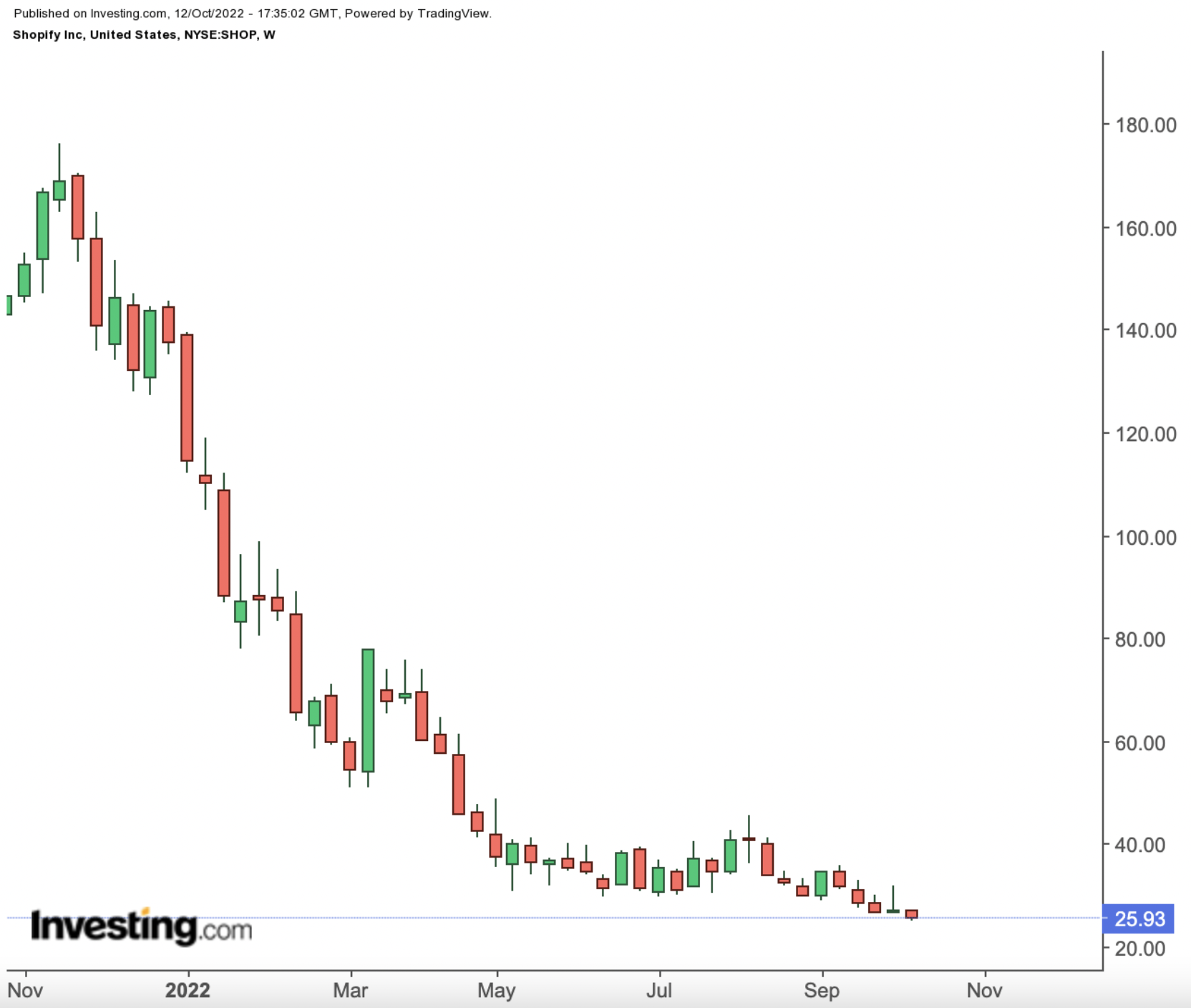- SHOP’s stunning decline from November highs doesn’t make a bull case, although downside risk still exists
- This remains an unprofitable company with decelerating growth and a valuation above $30 billion.
- The long-term opportunity is intact, but execution needs to improve.
Even in a market that has seen no shortage of staggering declines, Shopify (NYSE:SHOP) stock stands out. On Nov. 19, SHOP hit an all-time closing high of $169.06 (adjusted for this year’s 10-for-1 stock split). Since then, the stock has declined 85%. Some $175 billion in market capitalization has been erased.

Source: Investing.com
To some extent, the decline does make sense. Shopify stock has looked expensive for years, and at last year’s highs valuation became simply unsustainable. At the peak, Shopify traded for about 44x 2021 revenue. And relative to software companies that received similarly high multiples, Shopify had markedly lower gross profit margins (about 50%, against 80%-plus for some of the best software developers).
Meanwhile, growth stocks have been punished. E-commerce demand has pulled back amid a post-pandemic return to normalcy. It’s not a surprise, perhaps, that SHOP has declined sharply.
But even in that context, an 85% drawdown in 11 months is almost unthinkable. Bear in mind that SHOP now is down 35% since the beginning of 2020. There is much more going on here than simply a broad market decline and a correction after a bull run that went too far. The problem for SHOP stock is that even that multi-year decline seems driven more by the market’s response to changing facts than sheer panic-selling.
The Merchant Base
Back in 2017, well-known short seller Citron Research took aim at Shopify. The firm criticized Shopify’s marketing, which included a number of company affiliates promising what Citron called “get-rich-quick schemes.”
That call did not play out: Citron’s split-adjusted target for SHOP was just $6 per share. But one of the concerns the short seller raised — it would make a similar argument two years later — regarded the nature of the company’s merchant base.
In 2017, for instance, Shopify said it had about 22,000 merchants in its top tiers — and roughly 470,000 on its most basic plan. Citron wondered who those merchants were and, given the company’s seemingly aggressive market strategy, how long they might last.
Shopify now is on a path to 2 million merchants — but in this new environment, concerns expressed by Citron Research founder Andrew Left remain pertinent, even if his original bear case clearly did not play out. With normalcy returning, with inflation rising and with macro risks increasing, is the demand for entrepreneurship what it was in 2017, let alone 2021?
After all, the years even before the pandemic proved fertile ground for Shopify to recruit new merchants. Those new merchants drive high-margin subscription revenue, and also do much of the marketing to drive transaction-related fees as well.
Shopify does believe its merchant count will grow in the second half of this year. The company is likely correct: it’s too early to predict the end of Shopify’s growth.
Still, even after the decline this is not a cheap stock. SHOP trades at about 4x this year’s revenue — again, with gross profits around 50%. The company should be unprofitable even on an adjusted basis, and those adjusted figures exclude stock-based compensation which exceeded $250 million just in the first six months of the year.
Shopify’s growth potential simply may not be what it looked like in recent years, even accounting for pandemic effects. And if that’s the case, SHOP stock does not look at all cheap.
Competition And Management
That’s doubly true because in 2022, certainly, Shopify’s business doesn’t look quite as bulletproof as it did in the past.
Competition clearly is becoming an issue. Amazon.com (NASDAQ:AMZN) has used its “Buy With Prime” to target Shopify merchants and take away some of the platform’s transaction revenue. Shopify has spent billions of dollars already on a fulfillment network — including the $2.1-billion acquisition of Deliverr earlier this year — yet still seems behind Amazon. Fulfillment now, at least according to one analyst, looks to be a multi-year drag on earnings.
There are management concerns as well. Shopify already has replaced its chief operating officer and its chief financial officer this year. Chief executive officer Tobi Lütke has admitted the company hired too many employees during last year’s surge; Shopify already has laid off about 10% of its workforce.
There are some cracks in the story here, and real concerns about what Shopify’s results look like in a weaker macroeconomic environment. It wouldn’t be at all surprising if SHOP took another leg down from here.
To be sure, long term, the story is a bit more interesting. Shopify’s position in the e-commerce industry almost certainly remains intact. Profitability will improve over time. Fulfillment spending will slow as the network gets built out.
Still, it’s worth repeating: this is an unprofitable business valued at more than $30 billion in a bear market. Just because Shopify was worth $200 billion less than a year ago doesn’t mean it can’t be worth less than $30 billion a year from now.
Disclaimer: As of this writing, Vince Martin has no positions in any securities mentioned.
